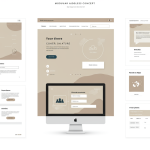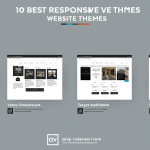
In the ever-evolving world of web development, maintaining visual consistency across a growing set of websites and components has become a critical challenge. Design tokens provide a robust solution by centralizing style values such as colors, typography, spacing, and animation durations. By abstracting these values into discrete, named tokens and integrating them into your styling workflow, you can achieve scalable, themeable website designs that are both easy to maintain and simple to update across multiple platforms.
What Are Design Tokens?

Design tokens are the atomic units of a design system, representing visual style attributes as named variables. Instead of hardcoding hex values, font sizes, or spacing units directly in your CSS or markup, you define them as tokens in a structured format like JSON or YAML. This approach transforms your brand’s design language into a single source of truth that can be shared between design tools, front-end code, and even back-end applications, ensuring consistency at every layer. Learn more about AI-Driven Website Themes.
Why Use Design Tokens?
Implementing design tokens streamlines collaboration between designers, developers, and stakeholders by providing a single source of truth for visual decisions. Tokens reduce duplication and human error by eliminating hardcoded styles scattered throughout your codebase. When you need to update a brand color, font family, or spacing scale, you adjust the token value once and propagate the change automatically across all components and pages. This makes feature development faster, design updates more reliable, and maintenance significantly easier over time.
Structuring Your Tokens
A well-organized token structure is key for scalability. Group tokens by category such as color, typography, spacing, border radius, and shadow. Within each category, define subgroups for semantic usage (e.g., primary, secondary, success, error). Adopt a clear naming convention that indicates both category and purpose, such as color-brand-primary or spacing-large. This predictable structure helps teams locate and apply tokens efficiently, reducing cognitive load and encouraging consistent usage across your ecosystem.
Storing Tokens in Versioned Files
Store your tokens in version-controlled files—commonly JSON, YAML, or even Sass maps—to track changes and enable rollbacks. By placing tokens in a dedicated repository or monorepo package, you ensure that every project consumes the same token set. Tag releases for major updates, and maintain semantic versioning so downstream projects can upgrade safely. A separate token repository fosters clear ownership, simplifies change management, and avoids unintended drift across implementations.
Consuming Tokens in CSS
To bridge tokens and styles, leverage CSS custom properties. At build time or runtime, inject token values into :root or theme-specific selectors. For example, define –color-brand-primary: #1e90ff; and then reference it in your styles like background-color: var(–color-brand-primary);. This pattern makes it trivial to swap themes or adjust individual values without touching component code, promoting separation of concerns between style definitions and style usage.
Theming with CSS Variables
CSS variables empower dynamic theming by allowing runtime value swaps. Define multiple theme scopes, such as .theme-light and .theme-dark, each setting a full suite of token-based variables. Users can toggle themes via a class change or media query, and all components automatically inherit the new palette. This strategy supports personalization, accessibility preferences, and seasonal updates while retaining performance and minimal bundle size overhead.
Integrating Preprocessors for Compile-Time Control
While CSS variables excel at runtime theming, preprocessors like Sass or Less can compile token values directly into static stylesheets when dynamic theming isn’t required. Import your JSON or YAML tokens into your preprocessor pipeline using helper scripts, then map them to variables or mixins. This approach yields optimized, static CSS bundles with zero runtime overhead—ideal for legacy browsers or ultra-performance builds where dynamic theming is less critical.
Tools and Frameworks for Token Management
Several open-source tools simplify token workflows. Style Dictionary by Amazon automates format transformations, letting you author tokens once and export them as JSON, SCSS, Android XML, iOS Swift, and more. Theo by Salesforce offers similar capabilities with a plugin system. Token Studio plugins for Figma bridge the gap between design and code, making it easy for designers to publish tokens directly from their artboards into your shared repository.
Integrating Design Tokens into Your Build Workflow
Incorporate token generation into your CI/CD pipeline to guarantee up-to-date assets. Set up scripts that validate token schemas, generate style artifacts, and publish versioned packages automatically on merge to your main branch. This ensures that downstream projects always receive the latest token files without manual intervention. Automated pipelines reduce human error, accelerate release cycles, and maintain a single, authoritative source of styling data across teams.
Version Control and Collaboration Workflows
Treat your token repository like code by enforcing pull requests, code reviews, and automated checks. Require schema validation tests to catch typos or invalid values before merging. Use commit guidelines that reference design tickets to track the rationale behind token changes. This collaborative process aligns design and development teams, promotes transparency, and provides an audit trail for when and why style decisions evolved over time.
Documenting Your Token Library
Comprehensive documentation is critical for adoption. Generate a token reference site that displays each token name alongside its visual representation and usage guidelines. Tools like Storybook can integrate token previews alongside component demos. Clear documentation helps designers and developers understand context, intended use, and any constraints, reducing misuse and encouraging adherence to design standards across your projects.
Performance and Fallback Strategies
While CSS variables have broad support, older browsers may lack native support. Implement fallback values by specifying static styles alongside var() references, ensuring graceful degradation. For example, background-color: #1e90ff; background-color: var(–color-brand-primary); provides a solid fallback for environments that ignore custom properties. Assess the performance impact of large variable sets and scope variables narrowly to minimize reflows triggered by style changes.
Case Study: Light and Dark Mode Themes
Consider a brand that needs both light and dark variants. Define color-neutral, color-background, and color-text tokens, each mapped to distinct values under .theme-light and .theme-dark. Users can switch modes via a toggle that adjusts the root class, instantly updating the entire color palette. This token-driven strategy eliminates duplicate style definitions and simplifies maintenance, since modifications in the core token file ripple through all theme contexts automatically.
Testing and Validation of Design Tokens
Automate token validation with schema checks to catch missing or misnamed entries. Implement visual regression tests by generating snapshot screenshots of key components across themes to detect unintended style shifts. Linters can enforce token usage in CSS and JavaScript, preventing hardcoded styles. By embedding these checks into your CI pipeline, you ensure token integrity and consistent application across your UI library.
Best Practices: Naming Conventions
Adopt a predictable, semantic naming convention to ease token discovery. Prefix tokens by category—such as color-primary-500 or spacing-sm—then optionally include usage intent, like button-bg or heading-font-size. Avoid ambiguous names like blue-light or size-large; instead, tie names to their functional role. Consistent names reduce confusion, accelerate onboarding, and make tokens self-documenting in code reviews and IDE auto-completion.
Best Practices: Scales and Categories
Design systems often rely on scalable scales—typographic scales (100, 200, 300), spacing increments (4px, 8px, 16px), and color shades. Define these scales once and apply them uniformly via tokens. Group scales into categories—typography, layout, color—so that designers and developers use the same cardinal steps. A coherent scale ensures harmonious layouts, intuitive visual rhythm, and predictable design outcomes across diverse interfaces.
Best Practices: Lifecycle Management
Over time, tokens may become obsolete as design direction shifts. Implement a deprecation workflow: mark tokens as deprecated in documentation, provide migration guidance, and remove old tokens in scheduled major releases. Clearly communicate breaking changes and sunset timelines. A controlled lifecycle process prevents bloat, keeps the token library lean, and encourages regular housekeeping so that only relevant tokens remain active.
Automating Token Updates and Linting
Integrate linting tools to enforce token usage rules and flag hardcoded values. Scripts can scan your codebase for style properties and suggest token replacements. Automate token updates from design tools with webhooks—when a designer publishes new values in Figma, a CI job can regenerate token files and open a pull request. This end-to-end automation keeps design and code in sync with minimal manual overhead.
Migrating Existing Projects to Token-Based Theming
Transitioning legacy code bases requires auditing current style definitions and mapping them to token equivalents. Start by extracting a style inventory—colors, font sizes, spacing values—then create corresponding tokens. Gradually replace hardcoded values in components, prioritizing high-impact areas. Use codemods or regex scripts to accelerate the process. Phased migrations reduce risk, allowing teams to adopt tokens incrementally without halting feature development.
Aligning Tokens with Your Design System
Design tokens are most powerful when embedded within a comprehensive design system. Synchronize token updates with design library releases in tools like Figma or Adobe XD. Maintain a shared roadmap so design and development teams coordinate token additions, deprecations, and revisions. Harmonizing your design toolkit and code library around a unified token set ensures that both sides of your product organization speak the same styling language.
Accessibility Considerations in Token Design
Design tokens should support accessibility requirements such as adequate color contrast, focus indicators, and scalable typography. Define accessible color tokens with WCAG-compliant contrast ratios and include alternate tokens for high-contrast mode. Provide multiple font-size tokens for different reading needs. Embedding accessibility into your token strategy up front promotes inclusive design across all themes and devices, ensuring that your site remains usable by everyone.
SEO Implications of Token-Driven Themes

While design tokens primarily affect styling, they indirectly influence SEO through performance and usability. Token-based theming fosters optimized CSS bundles—by generating only the styles you need—and reduces inline style bloat. Faster load times improve Core Web Vitals, which Google factors into search rankings. Consistent breakpoints and spacing also enhance mobile experience, contributing to better engagement metrics and lower bounce rates.
Future Trends in Theming and Tokenization
Theming and tokenization continue to advance with emerging standards like CSS Houdini, which may allow native token support in the browser. Variable fonts and dynamic color palettes promise richer, more personalized experiences. Expect tighter integration between design tools and code through automated APIs, enabling real-time token sync. Staying abreast of these trends will help you evolve your theming strategy and maintain a competitive edge in 2024 and beyond.
Conclusion and Next Steps
Design tokens are a foundational technology for building scalable, consistent, and maintainable website themes. By defining, storing, and consuming tokens effectively, you unlock a streamlined workflow that benefits designers, developers, and end users alike. Start by auditing your current styles, structuring a token library, and integrating it into your build pipeline. With proper governance, automation, and documentation, you’ll be well on your way to a future-proof theming architecture that scales effortlessly.
















No Comments